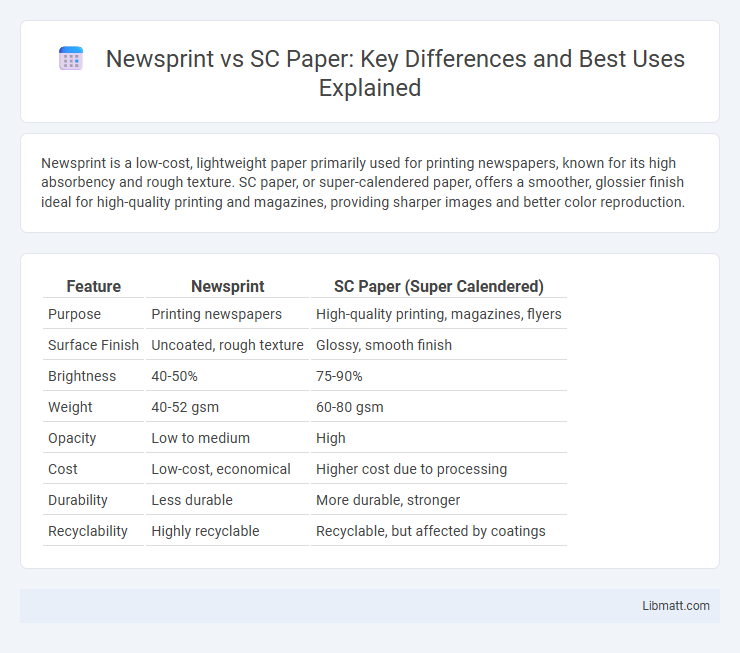Newsprint is a low-cost, lightweight paper primarily used for printing newspapers, known for its high absorbency and rough texture. SC paper, or super-calendered paper, offers a smoother, glossier finish ideal for high-quality printing and magazines, providing sharper images and better color reproduction.
Table of Comparison
| Feature | Newsprint | SC Paper (Super Calendered) |
|---|---|---|
| Purpose | Printing newspapers | High-quality printing, magazines, flyers |
| Surface Finish | Uncoated, rough texture | Glossy, smooth finish |
| Brightness | 40-50% | 75-90% |
| Weight | 40-52 gsm | 60-80 gsm |
| Opacity | Low to medium | High |
| Cost | Low-cost, economical | Higher cost due to processing |
| Durability | Less durable | More durable, stronger |
| Recyclability | Highly recyclable | Recyclable, but affected by coatings |
Introduction to Newsprint and SC Paper
Newsprint is an inexpensive, lightweight paper primarily used for printing newspapers, featuring high opacity and good ink absorption for fast drying. SC (Super Calendered) paper is a smooth, glossy paper designed for high-quality print applications like magazines and catalogs, offering enhanced brightness and improved image reproduction. Your choice between these papers depends on the desired print quality and cost-efficiency for your publication.
What is Newsprint? Key Features and Uses
Newsprint is a low-cost, lightweight paper primarily made from wood pulp, designed for high-speed printing of newspapers and other mass-distributed publications. It features good opacity, moderate brightness, and reasonable strength, fueling its widespread use in daily newsprint and advertising flyers. Your printing projects benefit from newsprint's affordability and recyclability, making it ideal for short-term, high-volume print runs.
What is SC Paper? Key Features and Uses
SC paper, or Super Calendered paper, is a high-quality coated paper known for its smooth finish and excellent gloss, making it ideal for vibrant print results. Key features include superior surface uniformity, increased brightness, and improved ink holdout compared to newsprint, which is uncoated and more porous. Your printing projects benefit from SC paper's durability and sharp image reproduction, commonly used in magazines, catalogs, and advertising materials.
Differences in Raw Materials and Production Processes
Newsprint is made primarily from mechanical pulp derived from softwood trees, which retains most of the wood's lignin, resulting in a less durable and lower-quality paper. SC (Super Calendered) paper is produced using chemical pulp from hardwoods and undergoes a supercalendering process that compresses the fibers, creating a smoother and glossier surface. Your choice between newsprint and SC paper depends on the desired print quality and durability, with SC paper generally preferred for higher-end printing and advertising materials.
Print Quality: Newsprint vs SC Paper
Newsprint offers a lower print quality characterized by rough texture and high absorbency, resulting in less sharp images and text due to ink spreading. SC paper (Super Calendered paper) provides superior print quality with a smoother, denser surface that enhances ink holdout and sharpness, making it ideal for detailed graphics and finer text. The difference in coating and calendering processes directly impacts the clarity and vibrancy of printed materials, favoring SC paper for premium print jobs.
Cost Comparison: Affordability and Value
Newsprint offers a significantly lower cost per ton compared to SC (Super Calendered) paper, making it the most affordable option for high-volume printing needs like newspapers and flyers. SC paper, while more expensive due to its smoother finish and higher quality, provides better print clarity and durability, adding value for premium publications or marketing materials. Your choice between the two should balance budget constraints with desired print quality and product lifespan.
Environmental Impact: Sustainability Aspects
Newsprint is often less sustainable due to its reliance on virgin wood pulp and shorter lifespan, resulting in higher deforestation and waste. SC (Super Calendered) paper, made primarily from recycled fibers, offers a reduced environmental footprint with improved recyclability and less energy consumption during production. Choosing SC paper supports your commitment to sustainability by minimizing resource depletion and promoting circular economy principles.
Typical Applications in Publishing and Printing
Newsprint is commonly used in newspapers, flyers, and mass-circulation publications due to its low cost and high printability, making it ideal for daily and weekly print runs. SC (Super Calendered) paper is favored in catalogs, brochures, and magazines where a smooth finish and higher print quality enhance visual appeal and detailed graphics. Both paper types serve specific roles in publishing, with newsprint emphasizing economy and speed, while SC paper prioritizes image clarity and durability.
Choosing the Right Paper: Factors to Consider
Choosing the right paper involves evaluating factors such as print quality, cost, and intended use. Newsprint is an economical option ideal for mass distribution and newspapers, offering lower brightness and less durability. SC paper (Super Calendered) provides a smoother surface and higher print quality, making it suitable for magazines and high-resolution images where visual appeal matters to Your audience.
Future Trends in the Paper Industry
Newsprint faces challenges due to digital media growth, shifting demand toward sustainable and recycled paper alternatives like SC (Super Calendered) paper, which offers higher quality and print clarity for magazines and catalogs. The paper industry anticipates increased innovation in eco-friendly coatings and fiber sourcing to reduce environmental impact, positioning SC paper as a promising option in sustainable printing solutions. Your choice between newsprint and SC paper should consider long-term trends favoring recyclability and premium print performance driven by consumer and regulatory pressures.
Newsprint vs SC paper Infographic

 libmatt.com
libmatt.com